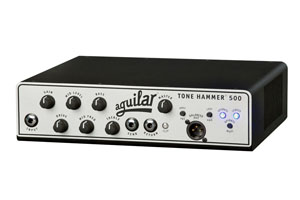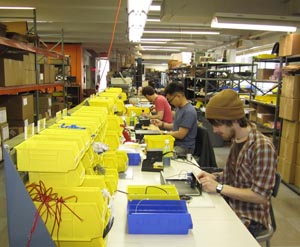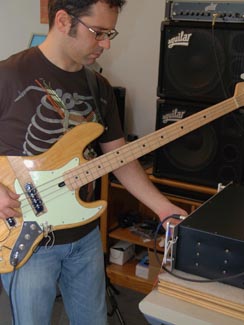Made In New York: Aguilar Amplification
THE BACK-STORY
“It’s super-light and super-loud,” says Dave Avenius, bass-player and CEO of Aguilar Amplification. Historically, this company has made their biggest strides while venturing into uncharted territory.
President Dave Boonshoft launched Aguilar in 1995 with the first tube preamp designed specifically for recording bass, and went on to help to revolutionize live amplification by popularizing the 12” cone-and-tweeter bass cab concept.
Today is no exception. Avenius is referring to the latest addition to their line, the Tone Hammer 500, a 3.8-pound, 500-watt head that fits in the front pouch of your average gig-bag. Despite its feather-weight status, this amp makes a lot of noise, and sports a tone that compares favorably to the rest of the Aguilar line.
“I think it’s going to be a home-run,” says Avenius, visibly excited. Surprisingly, each of these units (which list for $949 and can be found for under $700 street) is hand-assembled in the heart of downtown Manhattan. We visited Dave and Dave at their SoHo headquarters for a factory tour.
THE BUILD
“All of our assemblers are really smart guys. Each one knows how to build all of our products, and how to test every single one.”
In a reversal of the expected, Avenius and the team have begun to turn their backs on the assembly-line process, adopting a build strategy known as one “One-Piece Flow”. In effect, each amp and pedal is hand-assembled by one individual. Remarkably, this approach has proven to be more efficient, eliminating bottlenecks throughout the process. According to Avenius:
“It’s a bit more training for each technician, but we’ve also gotten better at designing the products so that they’re easier to build. And each of [the technicians] is even a little more invested in the process. It’s more satisfying, I think. They start with parts, and know that because of them, there’ll be a finished amp on the table that they created.”
This team builds all the heads, pickups, and pedals. Cabinets, which require more space, and kick up a lot more dust, are built in a separate facility in Ohio.
If Aguilar’s new build approach blends 21st century manufacturing with old-world craftsmanship, their niche in the market blurs the lines in a similar way.
“Some people call us boutique, but I don’t think that really sums it up,” Avenius says.
“If that means we care, and that a couple of our products are expensive, then, sure. But if boutique just means ‘small’ or that we don’t make a lot of product, it’s just not a distinction that makes sense. We really have a global presence. We build a lot of these [amps], and people are playing Aguilar all over the world.”
THE SOUND
Across the line, Aguilar’s basic sound is modern, but flexible.
Aguilar’s flagship head, the DB751 shows the roots of the company’s first preamp design, employing 3 12ax7s in the input stage. As for the power section, Aguilar turned to IC chips years ago and hasn’t looked back. “Unlike guitarists, we bass players need a lot of watts to reproduce the lows properly,” Boonshoft says. A solid-state power section ensures the necessary headroom at a manageable weight and realistic price-point.
At flat settings, each of the Aguilar heads we demoed sounded big, open, and articulate, featuring deep bottom, un-cluttered low-mids, and clear, focused upper midrange presence.
Dialing in some built-in gain on the DB751 adds some welcome girth and subtle grit until 12 o’clock, at which point pleasing, well-balanced saturation takes over. A “Mid-Boost” button morphs the sound of each of the Aguilar heads significantly, re-voicing the circuit to provide gigantic, blocky, aggressive-sounding midrange that’s appropriately grainy and in-your-face, while staying clear and well-defined.
For fans of the now-iconic big-and-sleek Aguilar sound, their defining GS line and new SL (“Super-Light”) cabinets dish out flattering depth and presence, while the custom DB series are voiced to emphasize the instrument’s punch, providing well-balanced, up-front midrange power, which this listener happened to prefer.
A line of pedals supplies specialty effects, like an analog octave pedal and dual envelope filter, as well as tone-shaping tools including the Agro overdrive and tweak-friendly Tone Hammer Preamp/DI.
“We’re not on a mission to color the sound, but it would make no sense to deny that sound has color,” Boonshoft tells us in an effort to clarify the sense of balance in his company’s philosophy.
“No one hears a concerto and says ‘Hey, listen to how flat that violin is!’ What they’re listening to is the music and the performance. When it comes to [electric bass], an amplifier completes the instrument. We’re just trying to do that in the most musical way possible.”
Justin Colletti is a Brooklyn-based producer/engineer who works with uncommon artists, and a journalist who writes about music and how we make it. Visit him at http://www.justincolletti.com.









